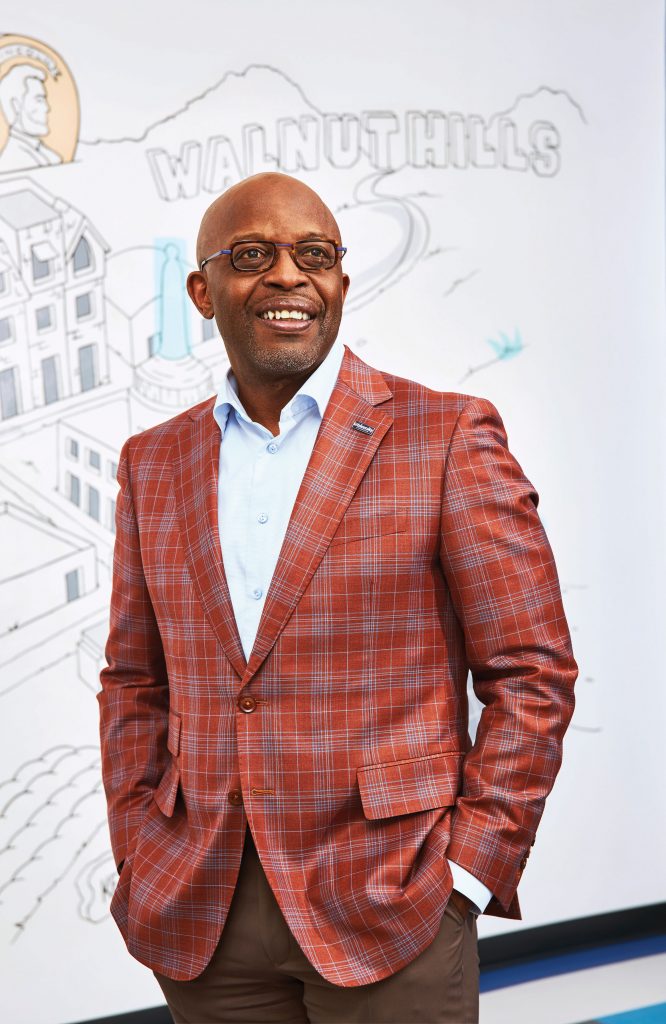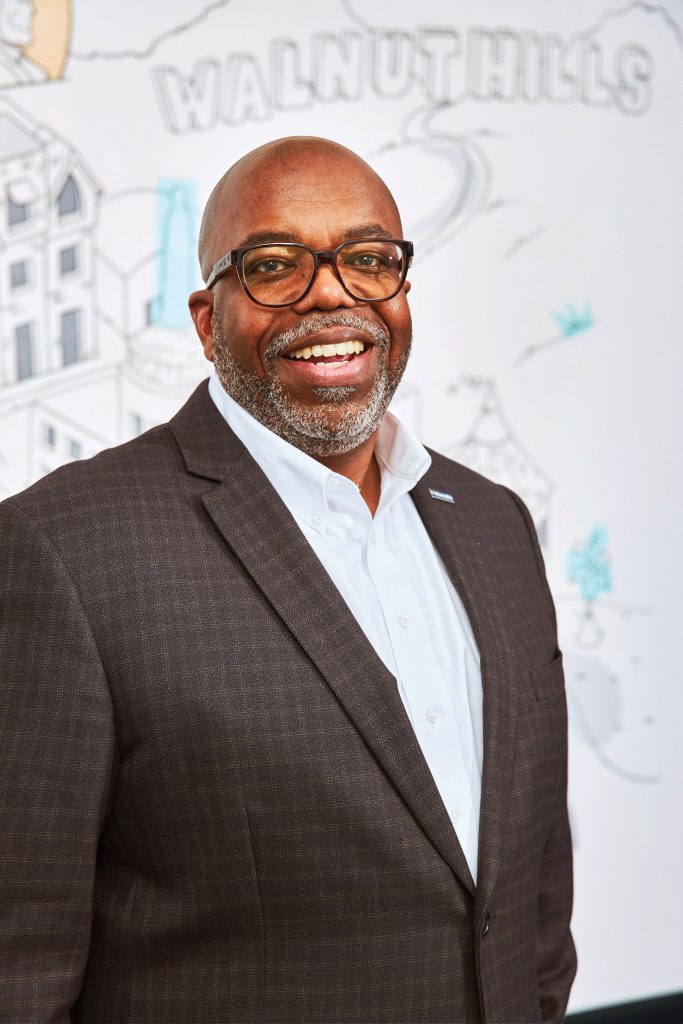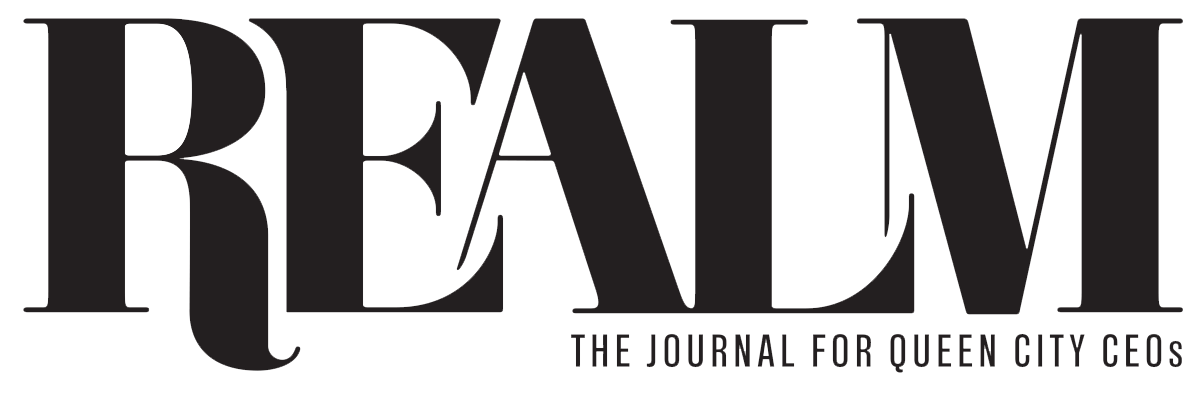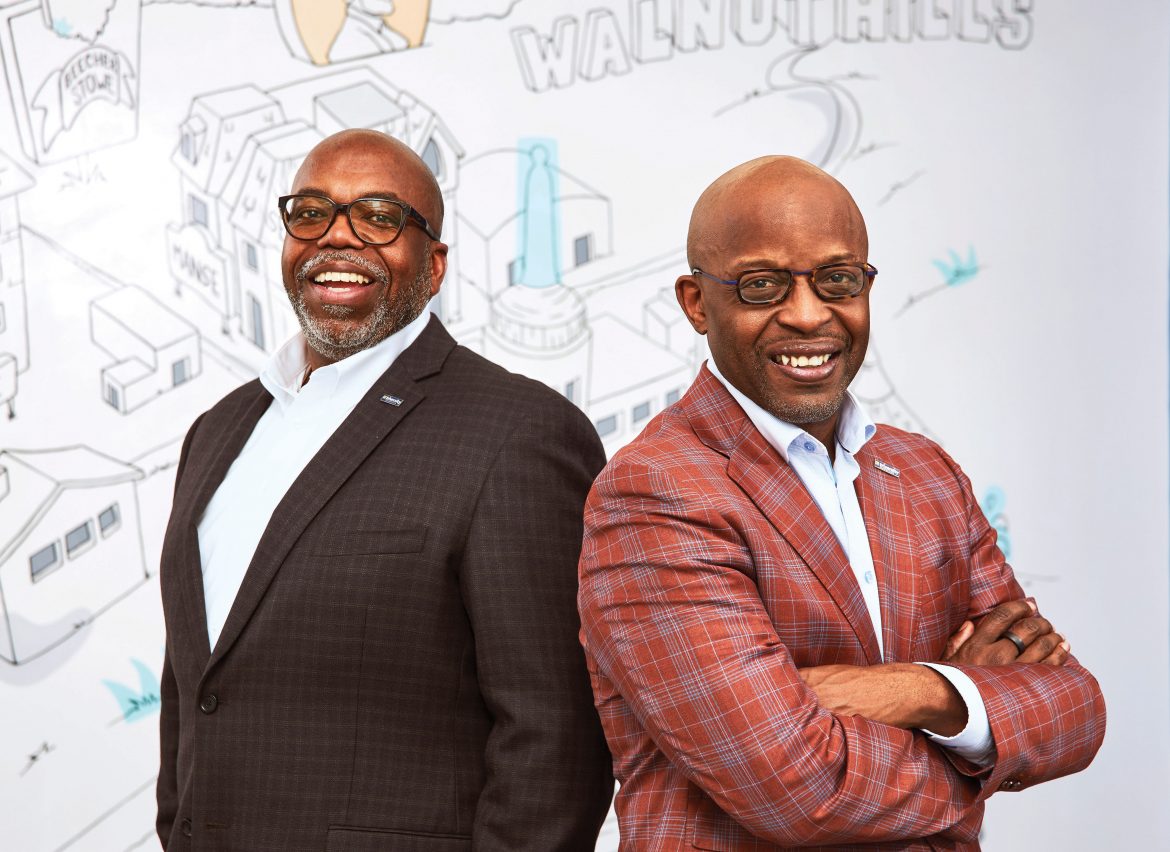When Mel Gravely, the long-time CEO of Triversity, stepped down as leader of the minority-owned construction company in January, he was fulfilling the next move in a long career built on intentional moves. “I’m not going to just talk about it,” he says. “If it’s going to be a thing, let’s make it a thing. That’s why we spend our time the way we do, which is why Triversity is the company it is—a high-performing company with the intention to be diverse because we know diverse is better.”
One of the key components of Gravely’s vision for the company is laid out in the multigenerational ownership model he’s researched, espoused, and advocated for throughout his career. Jim Watkins came to Cincinnati to serve as Triversity’s chief operating officer in 2012, and five years later he became president. He is now CEO.
“The vision that we have in wanting to become an evergreen company, a company that’s looking at the next 100 years, is really what fueled the transition plan,” says Watkins. “Mel and I tag-teamed together over the course of my 11 years here getting that foundation in place. And then he felt like it was time for him to move on to that next phase of business, which gives me the opportunity to step into the next phase for myself as well. That collective mindset, if you will, is what spirited the transition for both of us.”
Gravely says that talking about being a multigenerational business is one thing, but demonstrating that a company can actually transition to new leadership is what counts. “I had a CEO-in-waiting that I believe is going to be better at that job than I am,” he says of Watkins. “I didn’t have a construction background. He intuitively knows what he’s looking at and what to move around to improve margin and capabilities and set priorities.”
In addition to a construction background, Watkins also has a deep understanding of design, studying architecture and construction management at Purdue University. “I am very passionate about the built environment,” he says. “I started my career wanting to be an architect, and I realized I had an interest in it, but I had a bigger passion in being a builder. The triangle of it all—the creation, the building, and possession of the finished space—is what inspires me.”
Watkins, originally from Chicago, is passionate about the power of cities and their growth. In fact, his license plate is a mashed up version of “City Builder,” identifying both who he is and what he aspires to do at Triversity.
Like Gravely, Watkins has prioritized community engagement, which he believes is good for business and an important part of leadership and mentorship. Watkins is currently the first vice chair of the Cincinnati USA Regional Chamber and will be the chair beginning in 2025. He’s on the executive committee of REDI Cincinnati and has served on the city of Cincinnati’s Housing Advisory Board for the past two years.
He’s stepped up to push for the Fort Washington Way “caps” project with business and civic leaders, stressing they will bring growth and vibrancy to downtown and the region overall. He’s a leading voice on the development of housing in the region and is using his Triversity pulpit to push for housing policies that urge growth. (Read more about the city’s changing zoning and housing policies here.)
Chamber CEO Brendon Cull says Watkins is “destined to be a bigtime leader in the region. Because the Triversity transition has been intentional, the company’s success will be exponential.”
Gravely is originally from Canton, and shortly after he and his wife moved to Cincinnati in 1993 he left his position with IBM to join two partners running a civil and structural engineering firm they founded together. His first exposure to the region’s business community was when he volunteered to help organize a small business conference here. That’s where he met Clifford Bailey, founder and CEO of TechSoft Systems, who introduced Gravely to several businesspeople and invited him to join Downtown Cincinnati, Inc.

Photograph by Andrew Doench
“It just set me up for exposure and getting to know people,” says Gravely. “When people say, How did you get so connected? I can point back to the person who put me on that path. Clifford was very connected, and because of that I’m super sensitive to people who move here, because I know what one person’s help and support can do for you.”
As Gravely’s connections grew and strengthened, so did his resume. He was a founder of the African-American CEO Roundtable, part of Leadership Cincinnati Class 19, and earned his PhD from the Union Institute and University. His dissertation, in a sign of things to come, was on the topic of African-American entrepreneurship.
“The most transformational part to me is the ability to grow private enterprises that are multigenerational for Black people,” says Gravely. “Until we do that, we’re not going to solve a lot of deep social problems, because those problems are being solved in rooms that cost money to be in. I believe we’ve got to grow scalable multigenerational Black businesses in this country or we’re going to continue to replicate the challenges we face now.”
After four years teaching at Thomas More University, Gravely founded a consulting practice focused on minority business development, the Institute for Entrepreneurial Thinking, and wrote several books. In the early 2000s, at Bailey’s recommendation, he was hired by the Cincinnati USA Regional Chamber to write the business plan for what would later become the Minority Business Accelerator (MBA). That idea was first proposed by the Cincinnati Action Now Commission, an initiative formed in the wake of the April 2001 death of Timothy Thomas and subsequent riots.
Major business and nonprofit leaders across all sectors joined Gravely on the MBA steering committee to develop metrics and structure for an initiative that would accelerate the growth of existing minority-owned businesses. “It didn’t take very long for people to see the opportunity this program would create,” he says. “Cincinnati still today is one of the leading cities for scaled Black businesses in the nation.”
According to data gathered by the Alpaugh Family Economics Center at UC on behalf of the Greater Cincinnati/Northern Kentucky African American Chamber of Commerce, Black-owned businesses in the region generated $1.44 billion in total economic output in 2021. In February, USA Today published an article compiling the largest Black-owned businesses in the country. Number eight on that list was Hightowers Petroleum, owned by Stephen Hightower and based in Middletown, generating $450 million in revenue.
“When you look at the size of Black-owned companies in our city compared to cities around the country, we do pretty well,” says Gravely.
In fact, Triversity is one of Cincinnati’s largest minority-owned businesses, with $107 million in revenue in 2022, according to Cincinnati Business Courier. Gravely bought two-thirds of the company in 2009, with the other third owned by Messer Construction. He took ownership right as the Great Recession battered the economy, an especially difficult time for construction, but Triversity was the perfect case study for him to realize his vision for minority-owned businesses.
“It provided me the opportunity to stop talking about minority-owned businesses and go grow one,” says Gravely. “We focused on private sector, big customers with complex needs, because I understood that business from having worked at IBM with big customers. I understood how they bought from suppliers. There was no other secret to it than that.”
Triversity won a major contract from Procter & Gamble its second year in business, and the company still works with P&G. It also continues to partner with Messer Construction on projects, including upcoming renovations to the Duke Energy Convention Center downtown, and to manage projects for 3CDC. “Our reputation kept building and we kept building our staff, but we really wanted to build this culture and be intentional about Why,” says Gravely. “Our mission statement of creating a model of what a diverse and inclusive organization can be continues to permeate the organization today. We have a vision of being in business for the next 100 years.”

Triversity moved its headquarters and 100-plus employees from Norwood to Walnut Hills a couple of years ago. The $4 million project saw Triversity join several other businesses as a corporate anchor for the neighborhood, a move that symbolized its dedication to community. The building, empty since 1973, is on a two-block-long one-way street, a prospect Gravely says didn’t necessarily sound “appealing” but was intentional nonetheless. The renovation project was awarded to the Sanders Development Group, led by Robert Sanders.
“We do everything we can to provide opportunity to folks we think are really trying to move the needle,” says Gravely. “We did it because of what we could do in the community by bringing jobs there. But we also intentionally worked with an African-American developer who at the time hadn’t had a big break. We thought he was a good person to try to lift.”
A self-proclaimed Cincinnati kid, Sanders grew up in Over-the-Rhine attending Taft High School, Rothenberg School, and Lafayette Bloom School. “I’m actually trying to redevelop the Bloom property now,” he says. “It would be really cool if we can pull that off.”
Sanders attended Ohio State University before moving back to Cincinnati to work in commercial real estate and business banking. Most recently he worked for the Port of Greater Cincinnati Development Authority as director of commercial development before hanging out his own shingle in October 2019. Sanders Development Group focuses on large-scale, mixed-use, multi-family and community development projects in the urban core.

Photograph by Andrew Doench
“You have a company wanting to hire a minority developer to do a high-profile project of relocating its headquarters,” says Sanders. “That’s a decent amount of risk, right? I would argue there aren’t a lot of people just generally speaking willing to give someone that type of opportunity. But Mel and Jim trusted my experience, and I had the resume to back up real estate development, so we ended up getting the opportunity to be the main developer. It’s opened a lot of doors for us as a company.”
Watkins sees Triversity’s Walnut Hills headquarters as a crucial cornerstone for the neighborhood. The company’s presence represents an economic commitment that also spans community engagement. “It’s more than an office building,” he says. “We also thought about being a good corporate neighbor, so we have shared spaces. We wanted to participate in community events, which is something that’s always been fun to do, and also support neighborhood businesses. We’re hoping those kinds of things bring value to the neighbors who live here.”
Even after stepping down as CEO, Gravely stays busy. He remains on Triversity’s board as chair and still owns the same shares of company stock. He is a member of the Cincinnati Regional Business Committee, serving as the Triversity representative. He continues to provide business development assistance to Watkins and work on existing business relationships at P&G and elsewhere. Gravely will chair the ArtsWave Annual Campaign in 2025.
“I truly think we’re better together, and, again, I believe in being intentional,” says Gravely. “I told my wife that if I was going to have a tombstone, which I’m not, I’d want it say something like, This was an intentional dude. I don’t want life to just happen—I want to do what I can to steer it.”
Watkins agrees with the sentiment. “I’m most excited about growth opportunities and building new and deeper relationships with customers and the Cincinnati community at large. It all aligns with our vision to build a company that will stand and sustain itself for the next 100 years.”


